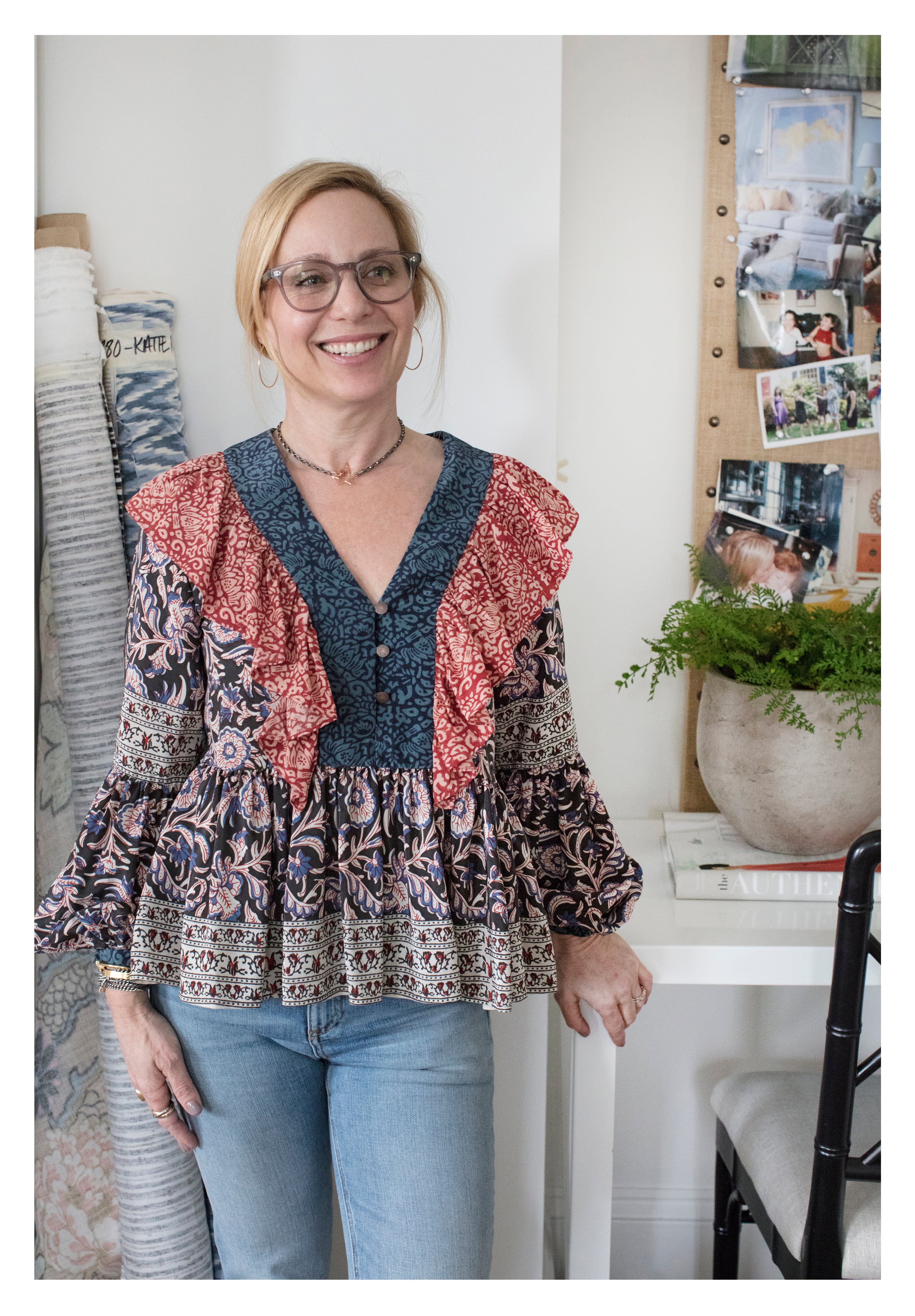The 50 States Project is a yearlong series of candid conversations with interior designers we admire, state by state. Today, we’re chatting with Katie Rosenfeld, a former Wall Street recruiter who moved to Wellesley, Massachusetts, in 2007 and launched a blog that ignited her design career. She spoke about why radical authenticity is fundamental to her business philosophy, how she pushes back on clients who question her value and how she’s reinventing and flipping smaller old homes.
You started a podcast, ‘Six in One,’ in late March in response to the pandemic. What made you feel like now was the moment?
My practice is small but close-knit, and one of the key elements—one reason I get up every day—is because I really love my staff. All of us being away from each other was really lonely and horrible, so what we wanted to do with the podcast was have an open dialogue. One of the gals in my office suggested the idea, and I thought it would be good because we could all just kind of talk freely. I didn’t think anybody would listen, so who cares! And then I thought, Well, gosh, if someone does listen, then they’ll have a good idea of what we’re really like, and whether or not we’d be a good fit [for their project].
The first two episodes were mainly just us missing each other—we don’t even have any guests, it’s just us talking! One of my employees suggested we get guests, so I DMed people on Instagram. It was so completely unpolished, but I guess it’s very authentic; it’s very representative of who I am and what my [firm] is. I like that there are scratchy sounds in it, that it’s not overly produced. All of that is part of that imperfection in life that I really like.
What has the response to the podcast been so far?
You know what—I don’t even know!
So you’re not incessantly checking your analytics?
Honestly, I have no clue who’s listening. I’m not a millennial, so to some degree, I just make the general assumption that I’m irrelevant, and if I’m not, I’m grateful.
How has that colored how you approach things like getting published or being on social media?
I wouldn’t hire a PR person if my life depended on it. I can tell right away when [a social media account is] not someone’s own voice. I don’t want to criticize other people, but for me it wouldn’t work. I always do my own pitches, because who better to describe your work to an editor than yourself? I mean, you worked on it.
I’m like the reality TV [version] of decorators, not the fantasy. It is what it is and I show it all. [Our] social media has never been written by anyone but me. I post my own stories—and you can tell. They’re awful! They’re not edited, they’re not pretty. They’re funny sometimes, but I don’t know what I’m doing. There are typos and photos that aren’t cropped properly, but there’s an authenticity that’s critically important to me and everything I do in life. That’s just fundamentally my business philosophy—I want to be authentic. I’m not perfect. No one is. And I don’t want people to expect me to be.
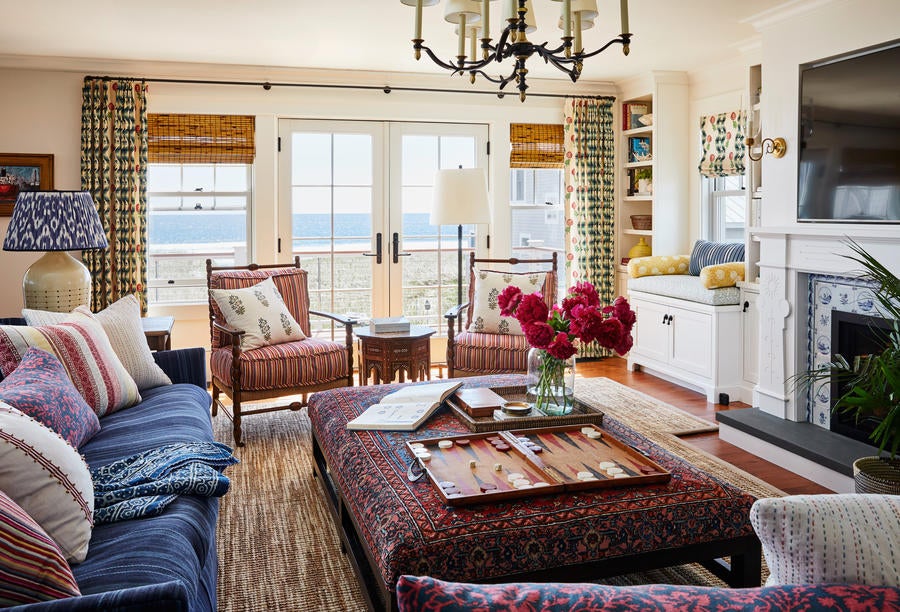
Your Instagram bio says, ‘Posting not scrolling.’ What does that mean, and how are you using the platform?
I don’t use Instagram other than to post. I do not scroll and I do not look at other people’s posts and stories. I still go on two or three times a day to post my stories and answer questions. I try to answer every single one, even if there are 74. I really like to engage, but I refuse to scroll because it makes me into a neurotic, crazy, insecure mess. So I don’t do it, and I’m so much happier.
Probably no one reads [my bio], but it says “posting” and then the red circle with the line that means no, and then “scrolling.” I don’t want people to think I’m a jerk if I don’t like their [content]. I would like it, but I haven’t seen it! I may like everything you do, and like you, but I’m never going to like your Instagrams.
Do you get work from Instagram? Is that why it’s so important?
Yes, I would say 90 percent of my clients come from Instagram now. So it’s weird—I’m using social media, but I’m not.
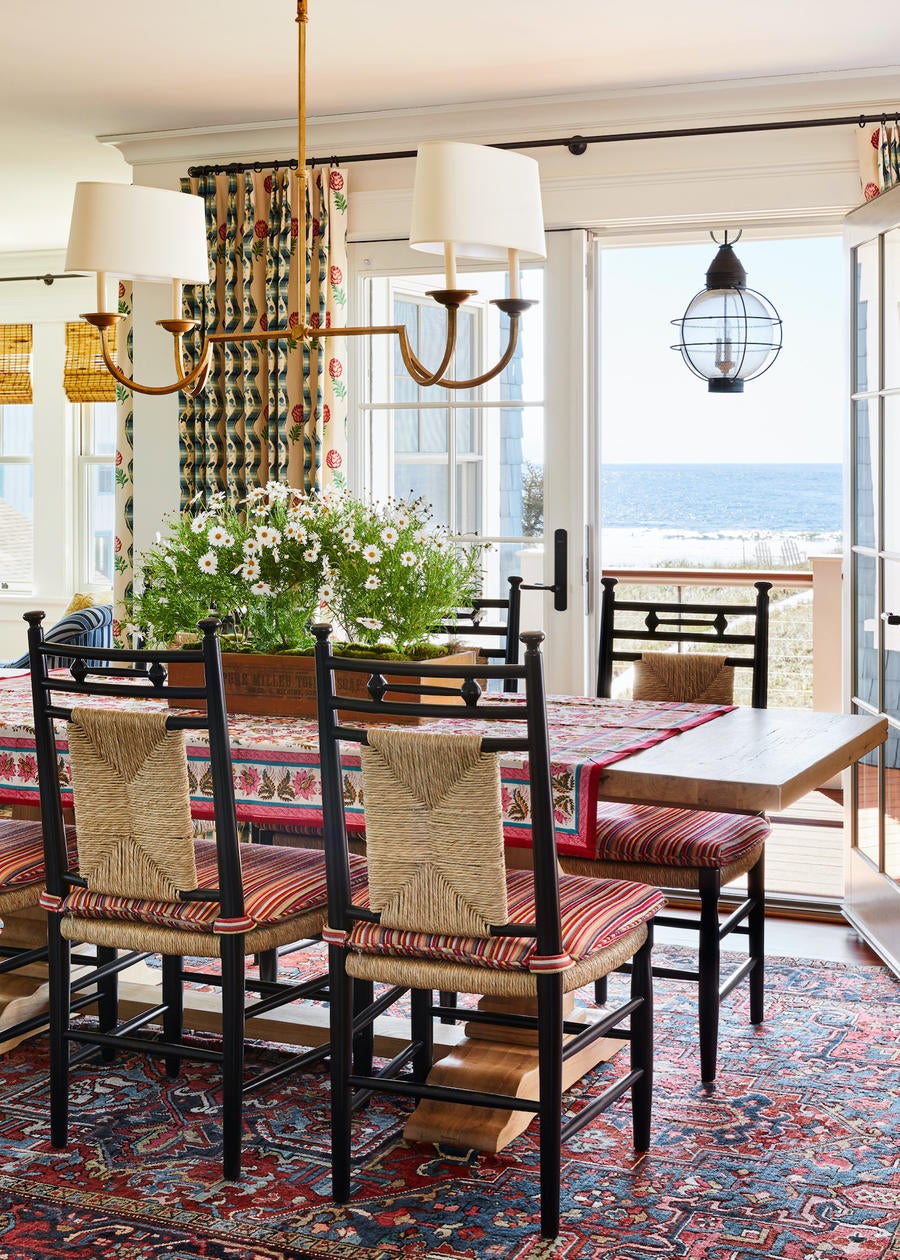
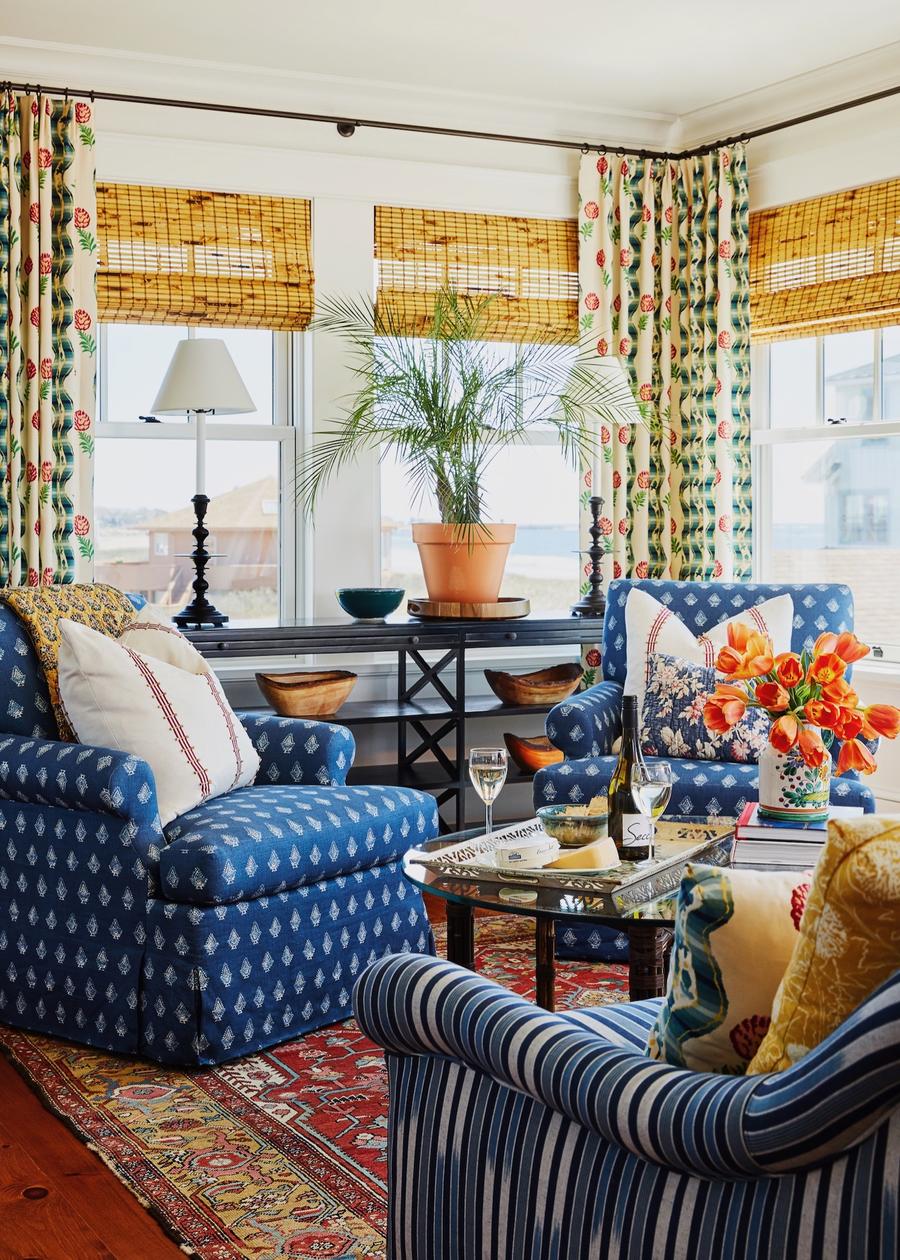
What is business looking like for you these days?
I’m back in the office, because Massachusetts just opened up. My people are not back; I am back by myself, which is kind of lonely. But amid this whole pandemic, my wingwoman who’s worked for me for eight years has made a life change and moved to Washington, which completely turned me upside down.
How soon into the pandemic did that happen?
Week one. It was first and foremost a personal loss. We were both bawling. She’s like a daughter to me; I had to give her that gift of spreading her wings, but at the same time, I was like, What is life going to look like after this—and without you? I mean, it just was hard.
How did you build that team, and what does it look like now?
My first employee, the one who just left, found me. She sent me her resume and had no experience [in design]. I get resumes all the time and I look at each and every one of them, because why not, right? And there was something about that resume, so I called her. I think there’s a lot of serendipity in life and something told me, “You know what—call this girl.” We made four appointments to meet each other, three of which I think I canceled because I’m so disorganized. When we finally met, she walked in and I was like, “This is a cool chick. You don’t know anything, but guess what—I don’t know that much either. I’ll teach you what I do know and we’re going to do something here.”
I hired her and she brought a lot of organization to my business. She understood that most of what I know is in my head, and she knew how to extract and organize it. When you work by yourself, you don’t need that skill, because it’s in your head. But when you get bigger, in order to have that information be useful and productive, somebody’s got to be able to leverage it. She knew just how to do that. And we also both have sick senses of humor and could finish each other’s sentences. I mean, she truly is like a family member of mine. In some ways, that was an amazing thing; [in other ways], I learned how unhealthy that is in the workplace. But she brought processes so I could do things that I wasn’t doing before.
And then what?
Right before that hire, my house got published in Better Homes & Gardens in 2012 and the phone started ringing, ringing, ringing. Then it got to a point where we got some jobs that were ahead of my skills, and it was really time to staff up. I got a project from a pretty high-profile local who was building a 22,000-square-foot home, and then I got lots more work around the same time, so I hired three other design assistants. Two are technical and do all the Revit, AutoCAD and interior architecture stuff, and one does project management, sits in on meetings, deals with clients, orders, and expedites. Now that my first hire is gone, I am revisiting the landscape of my office, and I need to hire. I feel so proud that I didn’t furlough—I’m hiring. That makes me so happy.
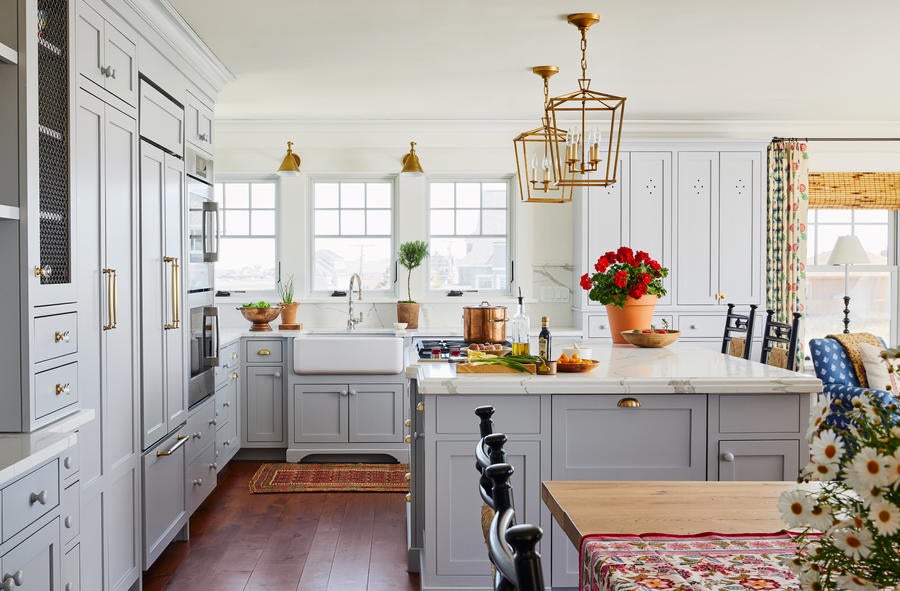
What will you look for in your next employee?
Oh, God, I don’t know. This quarantine has brought a lot of perspective and I’m taking a broader look at what the future looks like. The projects that I’m working on continue to be more complex and more architectural. [My firm] tends to have been this laboratory for young people to be mentored, but I think it’s time for me to hire people who have more experience and who bring more to the table, because I’m being asked to bring more to the table. That would be really good for my clients.
How did you start your firm?
I started a blog in 2007—that’s what I credit for my career taking off.
You weren’t always working in design. What was your path to this field?
I was a recruiter on Wall Street and then rose through the ranks to become the head of recruiting for one of the big investment banks. So I worked in New York, which is where I met my husband, and I was working super long hours. It was the 1990s, so there were definitely barbarians at the gates—you know, if those walls could only talk. The shit that I took is unbelievable to think about now, in the #MeToo era—but that gives me perspective, because I [actually] didn’t take it. Instead of burying the thoughts and comments, I would just say, “Get the fuck away from me.” So I guess that really goes back to the core of my business philosophy. You just be real and true and strong.
How long did you stay on Wall Street?
I left shortly after I got married. I was really miserable at my job, traveling a lot, working all-nighters. I was lucky enough to have a husband who was supportive and who had a career—he basically said to me, “What is the shit-to-pay ratio here? Get out of there and do what makes you happy.” So I decided that I wanted to do something creative, but I wasn’t really sure what that was.
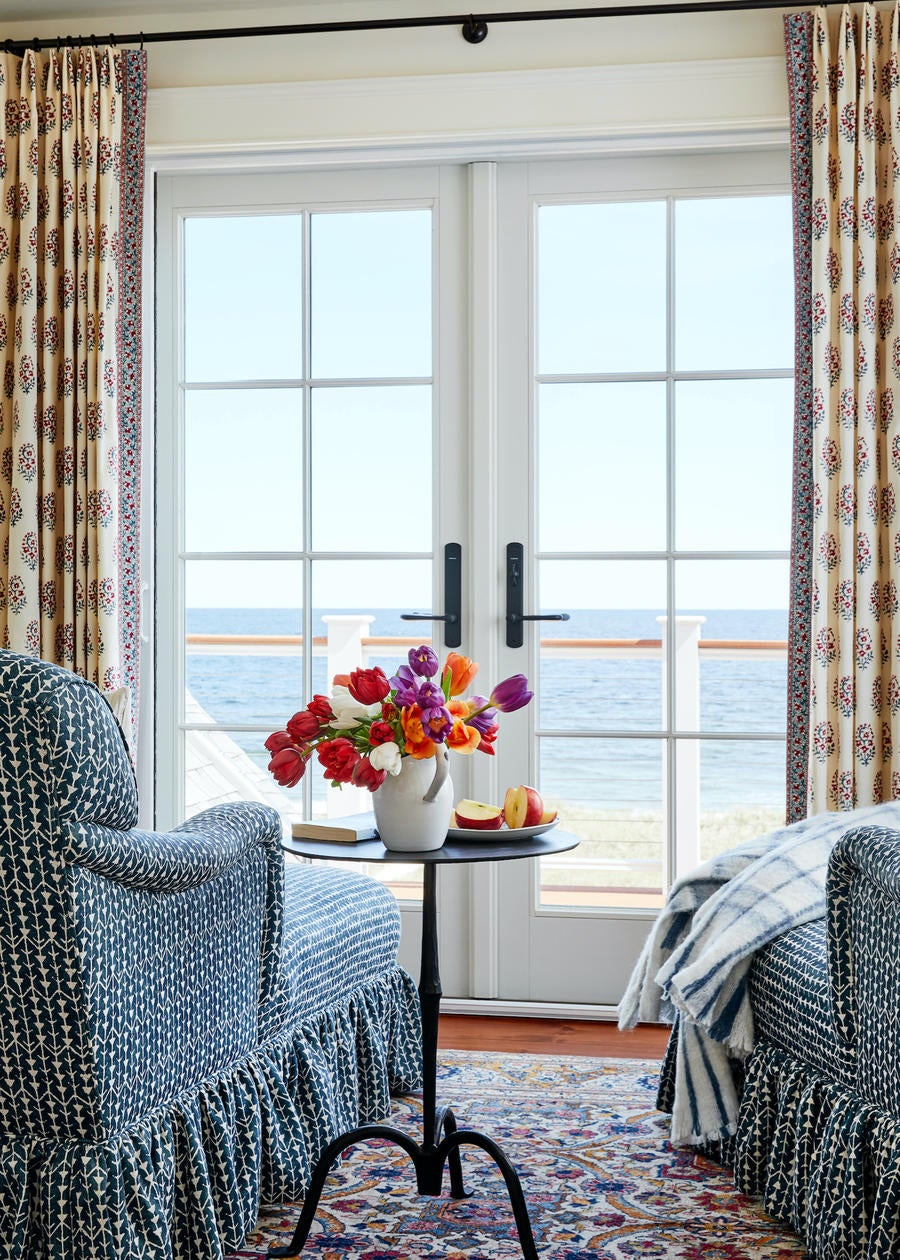
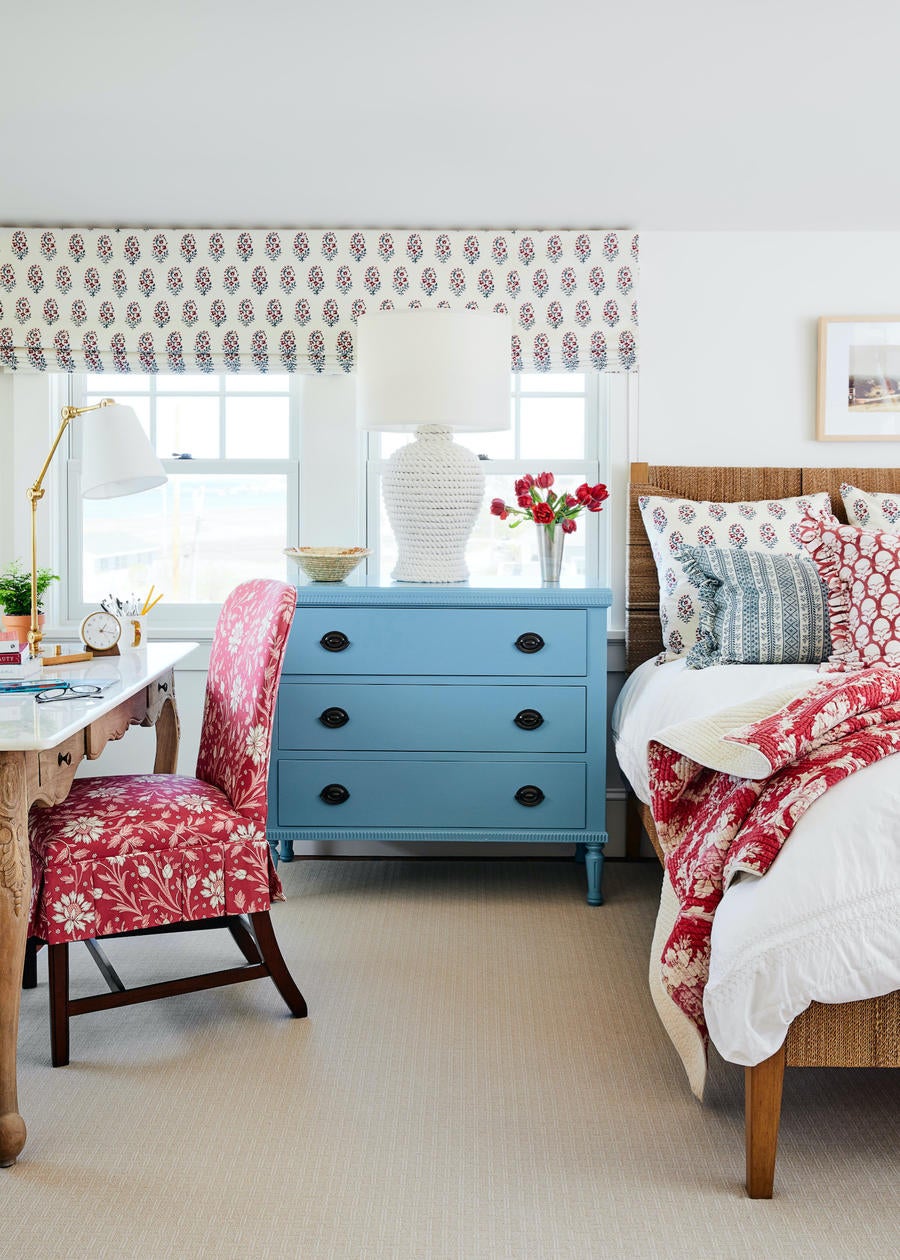
How did you wind up in design?
We eventually had a baby and moved to New Jersey. Over the next few years, I started a little business out of my home where I would go to the open studios in Williamsburg and Jersey City to find artists who I connected with. I offered them the opportunity to hang their art on the walls in my house and then I would have these salons, parties where I would invite 50, 60, 70 people over. I would have wine and cheese and people would buy art. And I thought, This is really cool, because it kind of decorates my house—I’m fickle, and it gets to change every couple of months—but also, people are actually buying this stuff.
Eventually, people would come and say, “I love this piece, let’s bring it over and try it—but actually, your kitchen is really spectacular, who did your kitchen?” And I would say, “I did.” And they would ask if I could do their kitchen. I was like, “Actually, I don’t know if I can do your kitchen.” But eventually the requests became overwhelming and it organically became clear that that was the space I should be moving into. And I did.
How did you start?
As I was starting to become a decorator—and I say “decorator” with a real purpose because I have no training—that’s when my husband was transferred to Los Angeles. So we moved to L.A., where we bought a midcentury modern house and I spent almost two years painstakingly restoring it to its original condition. I did all kinds of research on materials and threw myself into this renovation almost to teach myself how to do interior design. We renovated it, I furnished it, and as people would come over, I started to get work. And then my husband got transferred to Boston.
So you’re starting over again?
Yeah! I was a wreck. I was really disappointed, because things were really starting to happen out there for me. And I had two young children. But we have a strong marriage and I said, “OK, fine—but this is it. It.”
Is that where the blog comes in?
At that point, I had had my family in an apartment for so long for this renovation in L.A., I said to him, “We just have to buy a house where all I need to do is decorate it. No more renovations.” So we bought a really old house that had amazing bones in Wellesley, which is a beautiful bedroom community about 15 minutes from Boston. The house wasn’t completely updated, but updated enough, and I decorated the living shit out of it and started this blog called Bogle Street, which was our address.
I started the blog because I was really bored. I wanted to do design, but I didn’t know how to get there—I didn’t know a soul. The only people I was meeting were friends of my children, who all would come through the house. Some leads came through that, but the blog took off. I was no Erin Gates [the established Massachusetts designer and blogger of Elements of Style], but I had thousands of people reading it.
That’s amazing. And local business came from that?
Yes, and work all over. I got jobs in Atlanta, Washington and Charlottesville, Virginia. It was incredible. I think the reason the blog helped so much is that it was the beginning of blogs and everybody was reading them, but also because it was my voice. I’m sure there were typos, but it had a sense of humor and aimed to be authentic and educational. I was taking people with me on my learning journey. There are a million of these things out there today [and Bogle Street is defunct now], but this was early on.
That focus on authenticity—is that a business philosophy that you came to over time, or have you always worked that way?
On Wall Street, I had to have a hard candy coating to survive. But I’ve always been one of those people who’s a risk-taker—who jumped in before thinking about things too much. Early in my career, there was a lot of anxiety and fear because I was on my own, and as a young designer, it’s terrifying to deal with other people’s expectations and money and not be able to bounce your ideas off of someone who has your back or is more senior than you. But that’s the natural progression of life and career: You learn, you pay your dues.
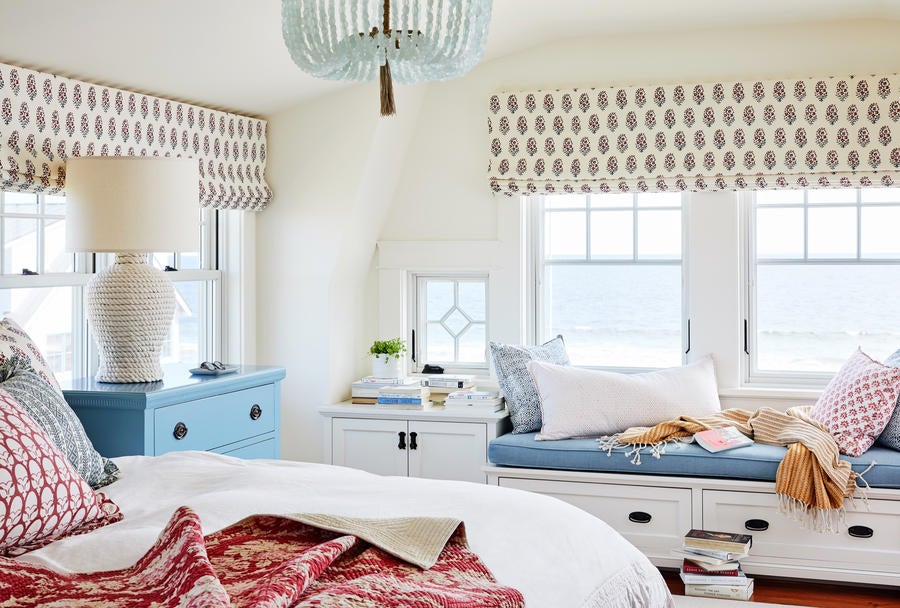
You used the word decorator earlier. Why is that a distinction you wanted to make?
Well, for me, I wear that as a badge of honor. I’ve had so many people say to me, “Oh, so I told them about my decorator—oops—I mean, my designer. I don’t mean to offend you!” And always my response is, “You’re not offending me. I’m a decorator! I didn’t go to design school! I can’t elevate cabinetry!” I don’t care what you call me as long as it’s nice—why should I be offended by being a decorator? That’s what I do. I decorate. Other people in my office elevate cabinetry. I work with kitchen designers. I don’t sew your curtains. I don’t sketch things. I can go around telling people I’m a designer, and maybe I am, but who really cares? Again, back to the philosophy part of me: Who cares?
What kinds of projects are you typically working on?
It depends on the time that you catch me, but usually I’m working on between 10 to 15 at a time. I’m looking at my [design] boards right now, and my projects are all construction and decorating. It didn’t used to be this way, but for the past eight years, I have found myself in the position of being hired to do gut renos and ground-up builds and then the interior design. Long-term, large-scale projects where I’m with these people for two years.
I will take my clients shopping—I pick out every faucet and tile, and we figure out what the kitchen and baths are going to look like. [I choose] every light and work with the architect to figure out where we’re going to do surface-mounted decorative lighting and integrate that into the reflective ceiling plan so that the builder knows where to put the wires. I really see myself as part of the team [with] the architect, the builder [and] the homeowner.
Did it take some adjustment to work in a team like that? How does your mindset change when you work in that way?
Yes, for sure. I have a very strong personality. So restraint, restraint, restraint is the name of the game for me. I can’t be a wild mustang when I’m working on these projects. When I was working on smaller projects solo, I could—it was me and the client. But with bigger projects, it has forced me to learn how to be managed and to manage, and I think that’s where some of my skills from Wall Street come in. Because you have to know where your place is, and you have to know how to communicate. You can be the best designer on earth, and if you can’t manage, your practice will never thrive.
How did you navigate that along the way?
So many mistakes. We’ve all had terrible divorces with clients, or times where I really screwed something up and it cost me a lot of money or been an embarrassment. You have to get a little beat up to learn these things—everybody gets beat up in this business, but not everybody tells you they do. It’s humbling when you install an expensive sofa that doesn’t fit. And you have to eat that. Even if you’re saying to yourself, “Holy shit, I can’t afford to replace this sofa!” You have to learn how to say to someone, “I don’t want you to worry. My mistake, and we’re going to fix it.” And then you go in your car and you scream. But you have to learn those things.
Who’s the right client for you?
It’s no different than meeting a friend or being on a date—you either have that chemistry and you laugh and connect, or you don’t. I love connecting with people and I try to pick good matches as far as clients go. I feel like I’ve finally gotten to that milestone in my career where I can do that. For example, I referred someone last week to another designer friend because I knew [the client and I] wouldn’t get along. I could tell right away that they would [be a better fit] because this other designer has a super laid-back personality. And I’m okay with that. There’s enough for everyone.
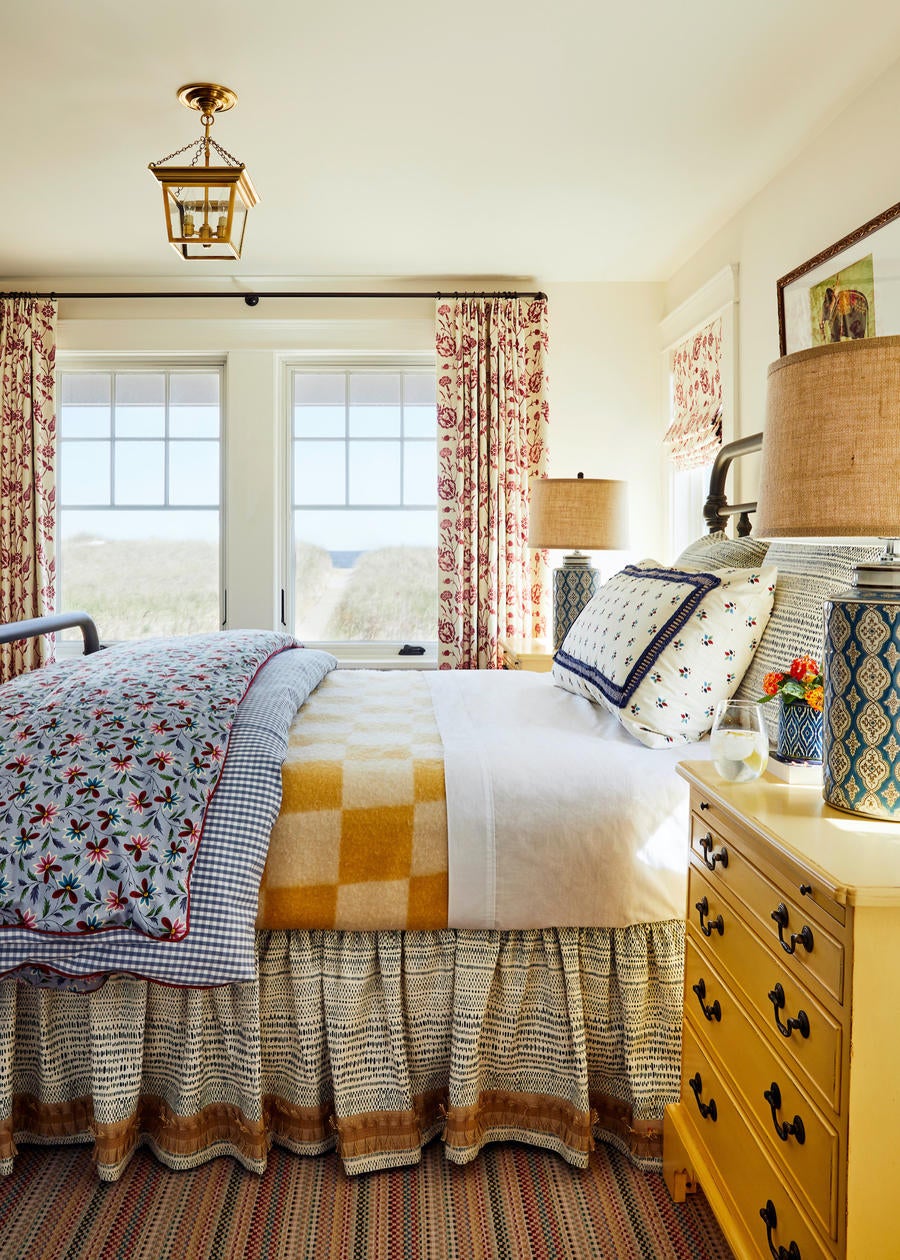
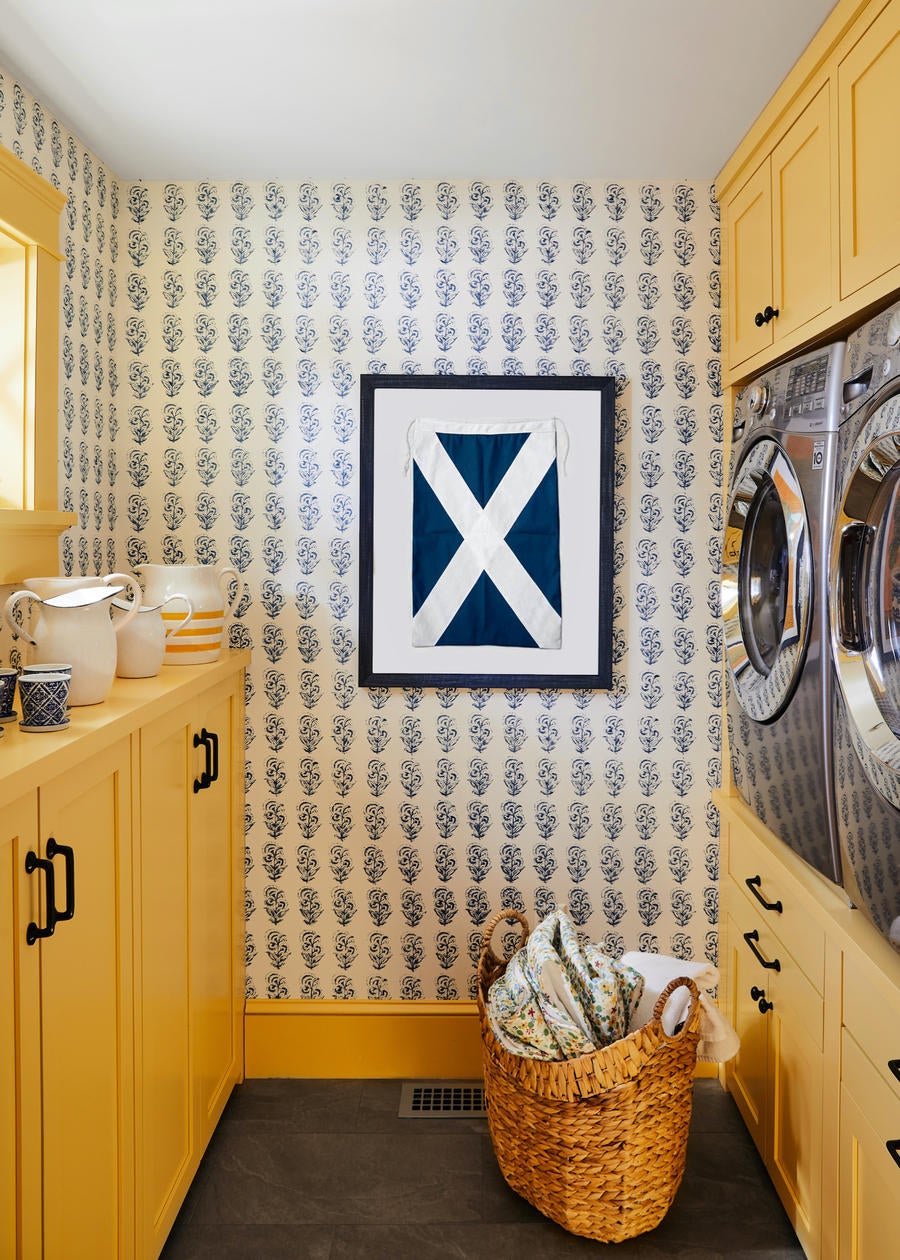
Is there an aesthetic piece to finding the right fit as well?
I think what I’m known most for is all the patterns and color that I use, and the layering of different things on top of one another. But it’s funny, I’ve also done some really clean projects that have no color and very little layering, and I love doing that kind of stuff. I wish more people would give me a chance to do things outside of what my branding is. I mean, you can’t be everything to everybody, but you can try.
I kind of look at myself like a hairdresser. That person, if they’re really confident, should be able to give you a bob that makes you look like an old lady going to the country club, if that’s what you want—or a mullet. That’s what I aspire to be able to do. I ought to be able to know who needs the bob and who needs the mullet and have it be the best one I can do. You have to know your client, you have to be able to flex your muscles and be very versatile.
How do you approach your relationship with your clients?
I always say that I’m the tour guide, but the client is the bus driver. Nobody wants a bossy decorator and nobody wants to be controlled—myself included. So when they hire a person to come into their house, which is intimate, you have to establish that element of trust. I have said to people so many times: “Do you want me to tell you what I think you want to hear, or do you want me to tell you what I really think?” I give them the option. Inevitably, they want me to tell them what I think. And they don’t always listen! I will say, “I think you’re making a mistake,” but at the end of the day, it’s their house and they should have control. Whatever they’re resisting, I’ll just bring it in for the photo shoot.
Do you always shoot your work?
No, I can’t. I want to shoot more than I have—and it’s really important for us to support photographers now too. They’re hurting and they need our support.
How much are you bringing with you to the photo shoot?
There are some projects where I don’t have to bring much of anything, and there are some projects where I literally have a truck.
How do the clients respond when they see the photos?
Oftentimes, they’ll keep some of the pieces. There’s an element where you can’t get somebody over the hump—but then you bring everything in and then they look at those pictures and they’re like, “I get it now. I get it.” And believe me, nothing makes me happier than not to have to do all those returns.
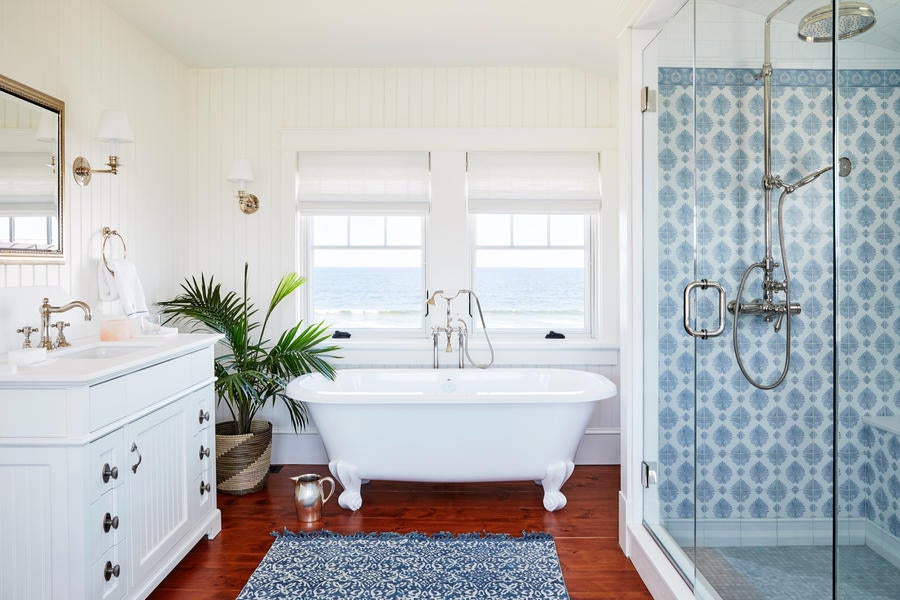
Where do you see opportunity to grow as you’re looking ahead, especially post–pandemic reflection?
Well, in the past couple of months, I’ve done some real estate flipping, which has been kind of fun. Or, not flipping—it’s a different philosophy and a different way of looking at it. I am not somebody that lives in a $9 million house. My husband doesn’t own a hedge fund—I am not my client in real life. I am very fortunate, and live a wonderful life, but I am not extravagantly wealthy. I couldn’t afford to hire me.
I invested in a couple of really beautiful, old, modest-sized homes, and instead of picking them apart or putting on an addition and making them into something newfangled, I tried to decorate the living crap out of them and do a lot of aesthetic and cosmetic improvements. It was very much about keeping the old and the quirky, and people really responded. So I’d like to do more of that—invest in older homes that a builder might buy and knock down, and save them by showing people that everything doesn’t have to be perfect to be super cool.
What are some examples of that?
If you have radiators, get radiator covers if you can’t afford to do your HVAC over. Everything doesn’t have to be so perfect. I think that’s one of the problems today: Everybody has to have it all, and they have to have it now. And it really doesn’t have to be that way. There is some area in between that’s a very happy place, and that’s the space I live in. So I want to bring that to other people. Not everybody can afford to buy a $2 million historic house and gut it, but what’s wrong with having a $1.2 million house that’s tastefully appointed that still has radiators?
Are you selling the properties with furniture in them?
I staged the first one, and some of the furniture sold. The second one sold before I could even put a hammer to a nail. And I just bought a third, but I think I’m going to move into this one.
Are you optimistic about the health of the industry in the coming months and years?
My practice is mostly major suburban work. I do houses. And I think a lot of affluent people who live in urban environments with little children are going to want to leave and have green space where they can at least throw their kids outside to play if they’re going to have to shelter at home. And for a certain echelon of clients who have a certain budget, I see a lot of opportunity for investing in the home.
On the other hand, if I were back 15 years ago still doing pillows, those projects are probably going to suffer right now. So it’s almost two different camps—the people who were and are affluent, but the people who are just doing refresh or lower-budget projects, maybe they lost their job or their kid’s not going back to school and they can't go back to work. I think that there’s going to be a lot of profiteering and a lot of suffering in this business. And at the same time, ironically.
How have you approached billing and talking about money over the course of your career?
I hate it, but I’m also committed to, and a stickler for, transparency. I have a contract, which explicitly states my profit margin on everything, how I’m going to bill hourly, and what the hidden costs of the project will be. In black-and-white, I tell them 50 times to Sunday that there’s inbound shipping and there’s also receiving and delivery, and this is the amount you should expect to spend on this, and this is the amount you should expect to spend on that. I made a flow chart for my clients that helps them understand the process and what kind of bills are going to come. Often, after the curtains are hung and they get the bill for labor, clients are like, “I thought I already paid for the curtains.” No, you paid for the fabric, but you also have to pay the installer. You can say it until you’re blue in the face and people still don’t remember.
The way I approach it is billing by the hour. Right now, my markup is probably lower than everybody else’s, but my fees are maybe a little bit higher. I’d like to get to a point where I don’t mark anything up at all—that’s where I’m headed.
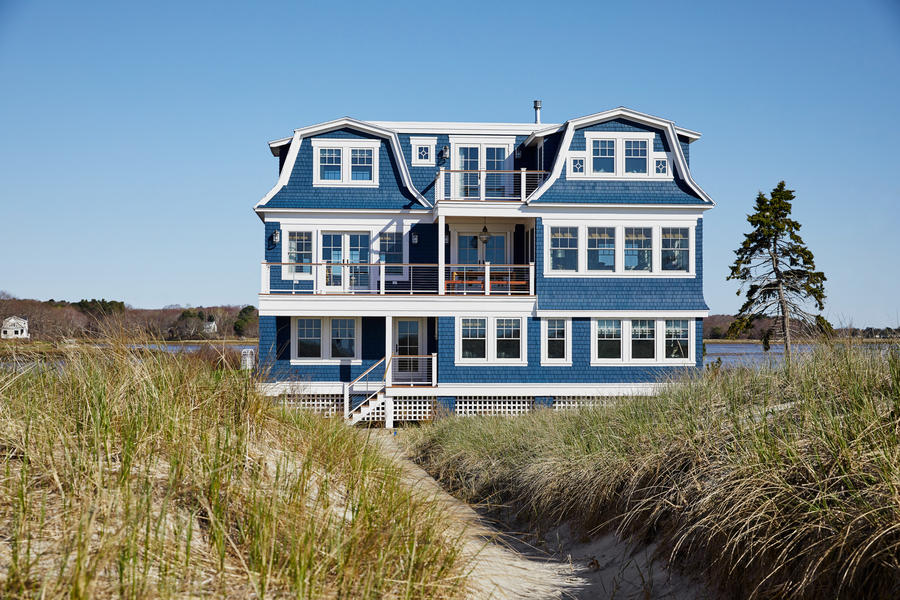
Why have you started to think that’s the way to go?
It’s just a constant headache, and I don’t want to fight the fight anymore. It’s a waste of time and energy, and I’d rather just bake it into my fee. What you’re paying us for is our creativity, our expertise, our advice, our wisdom and our hand-holding. So if you can get to a point where you’re like a lawyer and the client really values your expertise—we really are a fee-for-service business, and I’d like to get to the point where people look at me like they would a lawyer, an adviser, a consultant.
What is the road to getting there? Is it just slowly increasing your fees over time?
Yes, and having people be comfortable with and understand that. The reality is, you’re going to have to pay either way.
Right, it’s just framing it differently.
Yeah, it’s just different packaging, because no one works for free. You have to assume that people are smart and they understand that. If someone asks me to lower my markup [or my fees], that’s offensive to me. If a plumber comes in and fixes your pipe after it was spewing water and he costs $75 an hour, do you say to him, “You know, would you take $45?” I mean it’s the same thing. You wouldn’t do that, right? So why does someone feel they can do that [to their designer]? I always say, “If you go into a store and want to buy this bag and it’s marked $600, are you going to ask the clerk if you can have it for $525?” You have to put it into a context that people understand. And when I think like that, it might be a little unnerving, but I usually do it in a very tongue-in-cheek way that’s sort of like, “Give me a fucking break.”
Why is it that people feel so comfortable poking holes in design fees, do you think?
I really don’t know! I can’t figure it out—especially when they come in wearing handbags that cost more than they want to pay for a sofa. If you learn the answer to that question, please dial me up first. It’s such a struggle.
A client relationship rebounds from that, right?
Sometimes it does and sometimes it doesn’t. If you’re working with someone with whom this comes up a lot, for me, it’s usually someone I fire. Because I say to myself, “This is not working. You’re not listening to me, you’re not respecting me—and I’m not making you happy, either—so this can’t continue.” If it happens once—well, it’s happened once with almost everybody. I usually make my clients laugh, and that’s how I tell it to them straight.
To learn more about Katie Rosenfeld, visit her website or find her on Instagram.
















